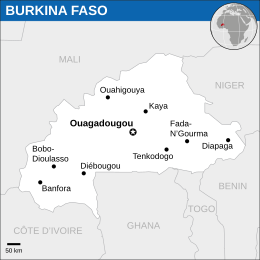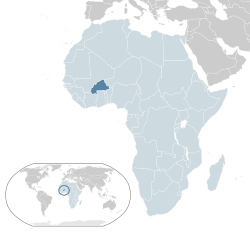Burkina Faso
An Burkina Faso (UK: /bɜːrˌkiːnə ˈfæsoʊ/, US: /- ˈfɑːsoʊ/ (![]() dangogon);[9] Pranses: [buʁkina faso]) sarong nasyon barat sa daga' sa Sulnopan Aprika na naglalaklak sa kahiwasan na 274,200 square kilometres (105,900 sq mi) asin tinataidan kan Mali sa norte-sulnopan, kan Niger sa norte-subangan, sa Benin sa sud-subangan, sa Togo asin sa Ghana sa habagatan, dangan sa Ivory Coast sa sud-sulnopan. An populasyon kan Hulyo 2019 kan nasyon na ini, susog sa tantya kan United Nations nag'aabot 20,321,378.[10] Ini dati inapod na Republika nin Upper Volta (1958–1984), alagad binago na sa pangaran na "Burkina Faso" kan 4 Agosto 1984 ni Presidente Thomas Sankara. An mga namamanwaan igdi inaapod na Burkinabé o Burkinabè (/bɜːrˈkiːnəbeɪ/ bur-KEE-nə-bay). An kabesera kaini iyo an kabesera aasin an pinadakulang siyudad iyo an Ouagadougou.The largest ethnic group in present-day Burkina Faso is that of the Mossi people, who settled the area in the 11th and 13th centuries. They established powerful kingdoms such as the Ouagadougou, Tenkodogo, and Yatenga. In 1896, it was colonized by the French Empire as part of French West Africa and on 11 December 1958, Upper Volta became a self-governing colony within the French Community. On 5 August 1960 it gained full independence with Maurice Yaméogo as President. In its early years, the country was subjected to instability, droughts, famines and corruption. Various coups have also taken place during the country's history in 1966, 1980, 1982, 1983, 1987, an attempt in 1989, 2015, and 2022. Thomas Sankara ruled the country from 1982 until he was killed in the 1987 coup led by Blaise Compaoré who became president and ruled the country until his removal on 31 October 2014. Under Sankara's leadership, he renamed the country Burkina Faso and launched an ambitious socioeconomic programme which included a nationwide literacy campaign, land redistribution to peasants, railway and road construction and the outlawing of female genital mutilation, forced marriages and polygamy.[11][12][13][14][15][16][17]
dangogon);[9] Pranses: [buʁkina faso]) sarong nasyon barat sa daga' sa Sulnopan Aprika na naglalaklak sa kahiwasan na 274,200 square kilometres (105,900 sq mi) asin tinataidan kan Mali sa norte-sulnopan, kan Niger sa norte-subangan, sa Benin sa sud-subangan, sa Togo asin sa Ghana sa habagatan, dangan sa Ivory Coast sa sud-sulnopan. An populasyon kan Hulyo 2019 kan nasyon na ini, susog sa tantya kan United Nations nag'aabot 20,321,378.[10] Ini dati inapod na Republika nin Upper Volta (1958–1984), alagad binago na sa pangaran na "Burkina Faso" kan 4 Agosto 1984 ni Presidente Thomas Sankara. An mga namamanwaan igdi inaapod na Burkinabé o Burkinabè (/bɜːrˈkiːnəbeɪ/ bur-KEE-nə-bay). An kabesera kaini iyo an kabesera aasin an pinadakulang siyudad iyo an Ouagadougou.The largest ethnic group in present-day Burkina Faso is that of the Mossi people, who settled the area in the 11th and 13th centuries. They established powerful kingdoms such as the Ouagadougou, Tenkodogo, and Yatenga. In 1896, it was colonized by the French Empire as part of French West Africa and on 11 December 1958, Upper Volta became a self-governing colony within the French Community. On 5 August 1960 it gained full independence with Maurice Yaméogo as President. In its early years, the country was subjected to instability, droughts, famines and corruption. Various coups have also taken place during the country's history in 1966, 1980, 1982, 1983, 1987, an attempt in 1989, 2015, and 2022. Thomas Sankara ruled the country from 1982 until he was killed in the 1987 coup led by Blaise Compaoré who became president and ruled the country until his removal on 31 October 2014. Under Sankara's leadership, he renamed the country Burkina Faso and launched an ambitious socioeconomic programme which included a nationwide literacy campaign, land redistribution to peasants, railway and road construction and the outlawing of female genital mutilation, forced marriages and polygamy.[11][12][13][14][15][16][17]
| Burkina Faso | |
|---|---|
| Kapitolyo | Ouagadougou 12°22′N 1°32′W / 12.367°N 1.533°W |
| Pinakadakulangsyudad | kabisera |
| Opisyal na mga tataramon | French |
| Mga etnikong grupo (2010 est.) | |
| Relihiyon (2006) |
|
| Demonym |
|
| Gobyerno | Unitary provisional government under a military junta |
| Ibrahim Traoré | |
| Apollinaire de Tambèla | |
| Lehistratura | National Assembly |
| History | |
• Republic of Upper Volta proclaimed | 11 December 1958 |
• Independence from France | 5 August 1960 |
| 3 January 1966 | |
| 28 October – 3 November 2014 | |
| 23–24 January 2022 | |
| Area | |
• Total | 274,200 km2 (105,900 sq mi) (74th) |
• Tubig (%) | 0.146% |
| Populasyon | |
• 2020 tantya | 21,510,181[1] (58th) |
• 2006 Sensus | 14,017,262 |
• Densidad | 64/km2 (165.8/sq mi) (137th) |
| GDP (PPP) | 2020 tantya |
• Kabuuhan | $45.339 billion |
• Per capita | $2,207[2] |
| GDP (nominal) | 2020 tantya |
• Kabuuhan | $16.226 billion |
• Per capita | $926[3] |
| Gini (2020) | medium |
| HDI (2019) | low · 182nd |
| Currency | West African CFA franc[6] (XOF) |
| Sona nin Oras | GMT (UTC ) |
| Nagmamaneho sa | right |
| Kodang pan-apod | +226 |
| ISO 3166 code | BF |
| Internet TLD | .bf |
The data here is an estimation for the year 2005 produced by the International Monetary Fund in April 2005. | |

An pinakadakulang grupong etniko sa presenteng Burkina Faso iyo an mga Banwang Mossi na nagbanwa igdi sa lugar na ini kan ika-11 asin ika-13ng siglo. Sinda nagtogdas nin mga poderosong kahadean arog kan Ouagadougou, Tenkodogo, asin Yatenga. Kan 1896, ini nakolonya kan Imperyong Pranses bilang parte kan Sulnopan Aprika Pranses asin kan 11 Desyembre 1958, an Upper Volta nagin nang magsadiring-paggogobyernong kolonya sa laog kan Komunidad Pranses. Kan 5 Agosto 1960 nakamit kaini an bilog na independensya bilang si Maurice Yaméogo iyo an Presidente. Sa mga enot na taon kaini, ini nag'agi nin instabilidad, paltik, pagkatingating asin korupsyon. Magkapirang mga coup an nagbungkaras sa historya kan nasyon arog kan mga minasunod: 1966, 1980, 1982, 1983, 1987, pagngata' kan 1989, 2015, asin an 2022. Si Thomas Sankara namoon igdi poon 1982 sundo 1987 kun kasuarin siya naputlan-buhay sa 1987 coup na pinamayohan ni Blaise Compaoré na iyo na an nagsunod na presidente asin namoon siya asta siya nahale sa pwesto kan 31 October 2014. Sa liderato ni Sankara, ginibo niyang sanglean na an pangaran kan nasyon asin pinangaranan niyang Burkina Faso, dangan siya nagbungsod nin ambisyosong programa sosyo-ekonomiko na kun saen yaon an kampanya sa literasiya, distribusyon nin daga sa mga tios, patugdok nin perokaril asin mga kalsada asin an pagbawal kan "pagtuturi" kan babae sa paagi pagtapyas kan itil, pwersahan na karasalan asin poligamiya.[18][19][13][14][15][16][17]
Toltolan
baguhon- ↑ "Archived copy" (PDF). Archived from the original (PDF) on 2016-12-21. Retrieved 2016-02-18.CS1 maint: archived copy as title". 16 November 2021.
- ↑ "Report for Selected Countries and Subjects".
- ↑ "World Economic Outlook Database, October 2021". IMF.org. International Monetary Fund. October 2021. Retrieved 10 January 2022.
- ↑ "Distribution of family income – Gini index". The World Factbook. CIA. Archived from the original on 13 June 2007. Retrieved 1 September 2009. Unknown parameter
|url-status=ignored (help) - ↑ Human Development Report 2020 The Next Frontier: Human Development and the Anthropocene (PDF). United Nations Development Programme. 15 December 2020. pp. 343–346. ISBN 978-92-1-126442-5. Retrieved 16 December 2020.
- ↑ CFA Franc BCEAO. Codes: XOF / 952 ISO 4217 currency names and code elements Archived 7 April 2014 at the Wayback Machine.. ISO.
- ↑ "Africa: Burkina Faso The World Factbook – Central Intelligence Agency". cia.gov. 2019. Retrieved 22 December 2019.
- ↑ Error sa pag-cite: Imbalidong
<ref>tatak; mayong teksto na ipinagtao para sa reperensiya na pinagngaranan naRGPH2006a - ↑ "burkina-faso noun – Definition, pictures, pronunciation and usage notes | Oxford Advanced Learner's Dictionary at OxfordLearnersDictionaries.com". www.oxfordlearnersdictionaries.com. Retrieved 20 November 2017.
- ↑ "Burkina Faso Population 2021 (Demographics, Maps, Graphs)". worldpopulationreview.com.
- ↑ "Violent Protests Topple Government in Burkina Faso". The New York Times. October 31, 2014. https://www.nytimes.com/2014/10/31/world/africa/burkina-faso-protests-blaise-compaore.html.
- ↑ Tens of thousands attend Burkina Faso protest, Protesters voice opposition to referendum that would allow Blaise Campaore to extend his presidential term, Al Jazeera (Reuters). Last updated: 1 June 2014 01:34.
- ↑ 13.0 13.1 Burkina Faso Salutes "Africa's Che" Thomas Sankara by Mathieu Bonkoungou, Reuters, 17 October 2007
- ↑ 14.0 14.1 Thomas Sankara: the Upright Man by California Newsreel
- ↑ 15.0 15.1 Commemorating Thomas Sankara by Farid Omar, Group for Research and Initiative for the Liberation of Africa (GRILA), 28 November 2007
- ↑ 16.0 16.1 "Burkina Faso coup: military says it now controls country after arresting leaders". The Daily Telegraph (Online edition) (United Kingdom). 17 September 2015. https://www.telegraph.co.uk/news/worldnews/africaandindianocean/burkinafaso/11870962/Burkina-Faso-coup-military-says-it-now-controls-country-after-arresting-leaders.html.
- ↑ 17.0 17.1 "Burkina Faso coup: Michel Kafando reinstated as president". BBC News. 23 September 2015. Retrieved 23 September 2015.
- ↑ "Violent Protests Topple Government in Burkina Faso". The New York Times. October 31, 2014. https://www.nytimes.com/2014/10/31/world/africa/burkina-faso-protests-blaise-compaore.html.
- ↑ Tens of thousands attend Burkina Faso protest, Protesters voice opposition to referendum that would allow Blaise Campaore to extend his presidential term, Al Jazeera (Reuters). Last updated: 1 June 2014 01:34.



